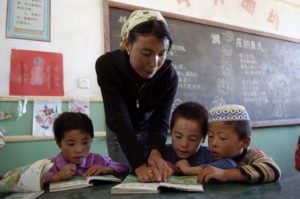It’s known as the PISA/TIMSS travelling caravan. Each time international tests results are released with league tables showing winners and losers a gaggle of researchers, academics and assorted fellow travellers descend on the highest-performing country or education system to analyse and report on “world’s best practice”. US education scholar Henry Braun has noted:
Delegations from lagging jurisdictions have been routinely dispatched to such destinations as Finland, Singapore and Ontario to ferret out the secrets of their success.
The target keeps changing
One problem with this way of thinking is that no one system consistently outperforms the rest. Based on the 1995 and 1999 TIMSS (Trends in International Math and Science Study) results, Asian education systems in Singapore, Japan, South Korea and Taiwan dominated. As a result, the focus was firmly on identifying the reasons the Asian tigers were performing so well. In the PISA (Programme for International Student Assessment) 2000 results, Finland ranked first in literacy, fourth in mathematics and third in science. Finland took centre stage and researchers and academics flocked to Helsinki to discover the reasons Finnish students performed at or near the top of the table. By 2012, once again, a different education system became the centre of attention. Finland slipped down the PISA rankings as a new winner, Shanghai, emerged as first in mathematics, science and reading.
Apples aren’t being compared to apples
A second problem when making comparisons is that the places we’ve identified as success stories are different to Australia. City-states like Singapore and education systems in highly performing places like Hong Kong and Shanghai have unique characteristics that set them apart from countries like Australia, England and the USA. Differences in geography, the numbers of students and schools, the student makeup (in terms of language, culture and socioeconomic profile) and how schools, including curriculum and assessment, are structured and managed have a significant impact on results.

Looking to other countries for success in education is like comparing apples to oranges.
It’s known as the PISA/TIMSS travelling caravan. Each time international tests results are released with league tables showing winners and losers a gaggle of researchers, academics and assorted fellow travellers descend on the highest-performing country or education system to analyse and report on “world’s best practice”. US education scholar Henry Braun has noted:
Delegations from lagging jurisdictions have been routinely dispatched to such destinations as Finland, Singapore and Ontario to ferret out the secrets of their success.
The target keeps changing
One problem with this way of thinking is that no one system consistently outperforms the rest. Based on the 1995 and 1999 TIMSS (Trends in International Math and Science Study) results, Asian education systems in Singapore, Japan, South Korea and Taiwan dominated. As a result, the focus was firmly on identifying the reasons the Asian tigers were performing so well. In the PISA (Programme for International Student Assessment) 2000 results, Finland ranked first in literacy, fourth in mathematics and third in science. Finland took centre stage and researchers and academics flocked to Helsinki to discover the reasons Finnish students performed at or near the top of the table. By 2012, once again, a different education system became the centre of attention. Finland slipped down the PISA rankings as a new winner, Shanghai, emerged as first in mathematics, science and reading.
Apples aren’t being compared to apples
A second problem when making comparisons is that the places we’ve identified as success stories are different to Australia. City-states like Singapore and education systems in highly performing places like Hong Kong and Shanghai have unique characteristics that set them apart from countries like Australia, England and the USA. Differences in geography, the numbers of students and schools, the student makeup (in terms of language, culture and socioeconomic profile) and how schools, including curriculum and assessment, are structured and managed have a significant impact on results.

Singapore, when compared to Australia, is small geographically, more homogenous in terms of language and culture and employs educational practices that have long been out of favour in Australia. These include streaming children based on their capabilities, and high-risk, competitive tests and examinations. As noted in a paper titled How not to reason with PISA data: an ironic investigation, there are also cultural factors explaining strong performance that are difficult, if not impossible, to transfer from one education system to another. Obvious examples include the impact of Confucian values and ethics that stress respect for authority (especially teachers), the belief that success is possible with motivation, concentration and hard work, and the idea that education is central if one is to achieve a better life.
Confusing cause and effect
Confusing what has led these countries to success represents the third difficulty in assuming that what appears to lead to success in one country can easily be transferred to another. Hannu Simola, in his paper The Finnish miracle of PISA: historical and sociological remarks on teaching and teacher education, when discussing why the Finnish education system performs so well, notes the teachers are conservative in nature:
It is significant that radical labour-union politics, not to mention the extreme Left, have been virtually non-existent in the Finnish teaching profession.
Ludger Woessmann, in Schooling Resources, Educational Institutions, and Student Performance: The International Evidence, also implies that teacher unions have an adverse impact on student performance. He says unions:
have the explicit purpose of furthering teachers’ own interests against the interests of other agents involved in the education process,
leading to unions:
acting opportunistically to further goals different from students’ performance.
To assume that all we need to do in Australia to improve test results is to reduce the influence of the Australian Education Union, while being attractive to some, is both undemocratic and guilty of assuming cause and effect.
There are some benefits of overseas comparisons
PISA and TIMSS tests have been held for many years. As a result, there is a good deal of research identifying the characteristics of stronger-performing education systems from which states and territories can learn. The early ethnographic work videotaping Japanese and American classes detailed in Harvard publication The Teaching Gap reveals how the lessons in Asian classrooms are more explicit, clearly structured and coherent and there is an expectation that all students, with the necessary help and applications, can succeed. A more recent publication by the Grattan Institute, Catching up: learning from the best school systems in East Asia, also identifies important lessons from successful Asian education systems. Positive factors include giving teachers more time to work collaboratively and to mentor one another, ensuring that teacher education, textbooks and the curriculum are mutually supportive and focus on improving classroom practice. It should also be noted that while Australian students do not perform in the top tier in PISA and TIMSS tests, there is some cause for celebration. Students in the Australian Capital Territory perform well above the Australian average and often match the performance of top-performing overseas education systems. In terms of lifting the performance of students from disadvantaged backgrounds it is also important to note that Catholic schools, based on an analysis of the 2009 PISA results carried out by the Australian Council for Educational Research, achieve an equity rating exceeding that of Finland.

